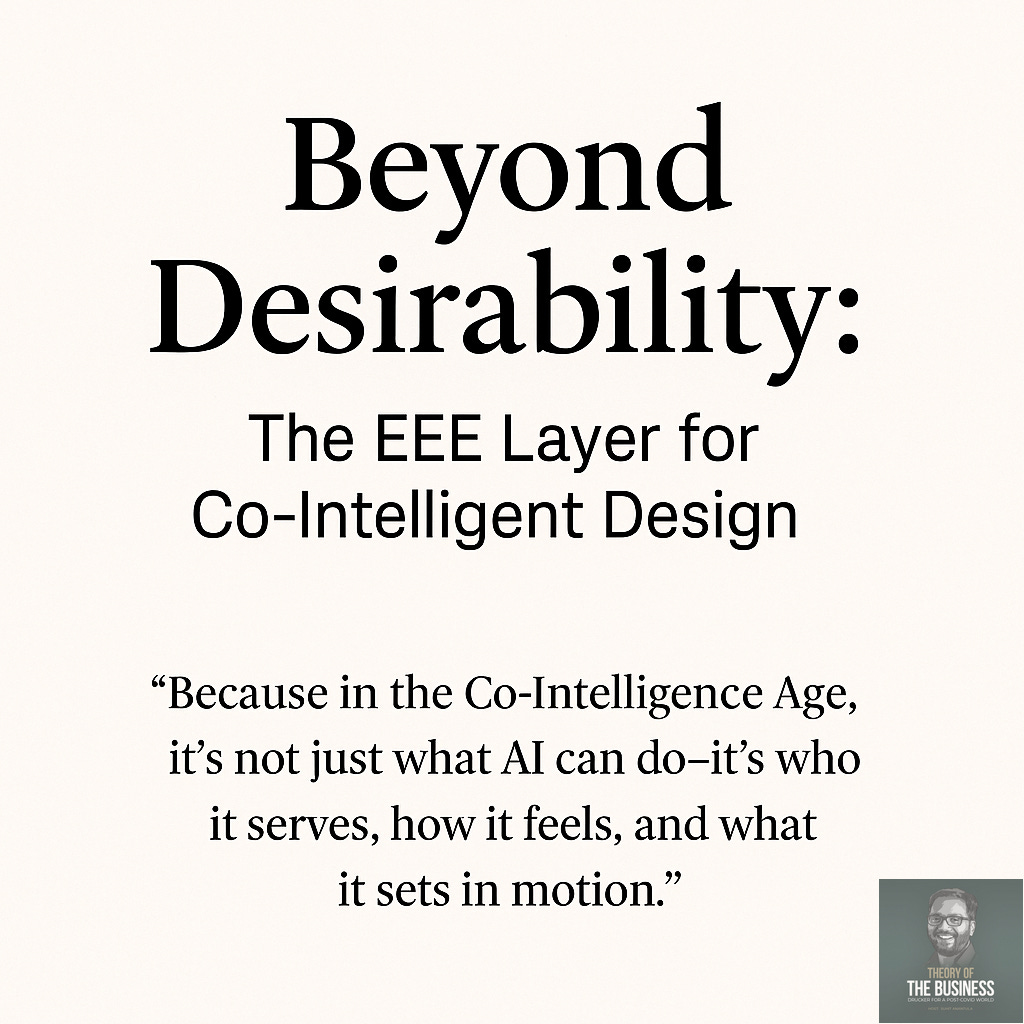Beyond Desirability: The EEE Layer for Co-Intelligent Design
Key framework from The Helix Moment, to be published soon.
Series of articles introducing the core concepts of The Helix Moment. Lines Loops Vibes, Strategic Rhythms, Helix Nexus GPT, Human-AI Collaboration Modes.
For decades, we’ve evaluated innovation through the lens of three questions:
Is it desirable?
Is it feasible?
Is it viable?
The DFV lens helped us bridge strategy, design, and execution. But in the age of AI—where systems learn, evolve, and increasingly shape human experience—these three questions are no longer enough.
We need a new layer of inquiry. One that doesn’t replace DFV, but deepens it.
That’s where EEE comes in.
EEE = Ethical, Emotional, Emergent
At its core, the EEE layer introduces three human-first lenses to AI strategy, product development, and system design:
Ethical → What values does this solution embed or erode?
Emotional → How does it feel, and what does it foster in human relationships?
Emergent → What might evolve that we can’t yet predict?
Each layer invites teams to pause—not to slow down innovation, but to design with foresight.
Because in the Co-Intelligence Age, it’s not just what AI can do—it’s who it serves, how it feels, and what it sets in motion.
〰 The Ethical Check: Designing with a Compass
Too often, ethics is treated like a compliance checkbox—something to review at the end. But in AI, ethical choices are baked into every data set, every interface, every automation.
Ethics is design intuition.
It’s also strategic foresight.
Ask:
What values—explicit or implicit—are we encoding here?
Who might this system help, and who might it unintentionally harm?
Does this increase or diminish human agency?
When an AI system makes a decision faster than a human, it still carries human consequences. Designing ethically means anticipating those consequences, building in redress, and protecting agency.
AI Tip: Use AI tools as an Ethical Advisor—ask them to simulate second-order effects, flag potential biases, or generate scenarios from multiple stakeholder viewpoints.
〰 The Emotional Check: Designing for Trust
Emotion is not the enemy of logic—it’s the fuel for adoption.
If a system frustrates, alienates, or intimidates people, they won’t trust it. And if they don’t trust it, they won’t use it—or worse, they’ll be harmed by it without understanding how.
Ask:
What does this feel like for the user?
Does it build trust? Connection? Or isolation?
How will we maintain psychological safety—especially when the AI gets it wrong?
In many ways, emotional design is the new UX. Not just frictionless journeys, but emotionally resonant ones.
AI Tip: Use AI tools as Emotion Sensors—run sentiment analysis on user feedback, test content tones, or prototype alternate interaction styles to evoke the right emotional cues.
〰 The Emergence Check: Designing for What Can’t Be Planned
Most traditional strategy is built on prediction. But in AI-powered systems, the most valuable outcomes often emerge—not from planning, but from possibility space.
We must design for evolution, not just execution.
Ask:
What new behaviours, business models, or unintended uses might this enable?
How will this system learn—and what will it teach us in return?
Do we have feedback loops and weak signal detection in place?
Emergent design doesn’t mean chaos. It means setting up conditions where adaptive value can flourish—while staying alert to risks and ripple effects.
AI Tip: Use AI as an Emergence Partner. Ask it to explore “what if” futures, scan for unexpected patterns, or stress-test ideas against evolving user needs.
Why EEE Completes DFV
So how do these two frameworks come together?
DFV keeps us grounded. EEE makes us wise.
Here’s how they integrate:
Desirable + EEE → Not just user needs, but emotional resonance, cultural fit, and human connection.
Feasible + EEE → Not just what can be built, but whether it evolves ethically and responsibly.
Viable + EEE → Not just profits, but long-term trust, learning capacity, and adaptive advantage.
Together, they create a new design intelligence—one that doesn’t just optimise for efficiency, but orients toward human flourishing.
Putting EEE Into Practice
This isn’t just a theory. It’s a design review you can run.
Bring your cross-functional team together. Choose an AI use case. And run through three key questions under each EEE lens:
🌀 Ethical
What core values are we upholding or challenging?
Who benefits? Who could be marginalised or harmed?
🌀 Emotional
What emotional experience are we creating?
Does it foster trust, empathy, and connection?
🌀 Emergent
What unexpected futures could this unlock—or disrupt?
Are we learning as fast as the system is evolving?
This simple conversation creates clarity. Tensions surface. Trade-offs become explicit. And most importantly, you shift from building AI tools to shaping AI systems.
The Helix in Action
The EEE layer is part of a deeper pattern we see across all high-impact strategy today:
Moving from linear optimisation to iterative evolution.
From knowing to noticing.
From technical feasibility to human alignment.
Because the future isn’t just what we build.
It’s what we set in motion.
Suhit Anantula is a strategy architect and founder of The Helix Lab, helping leaders build co-intelligent organisations through AI, design, and rhythm. His upcoming book, The Helix Moment, redefines how we think about strategy in the age of AI.


